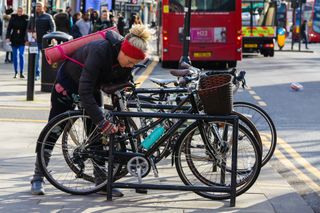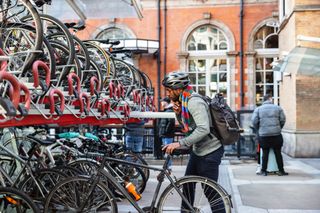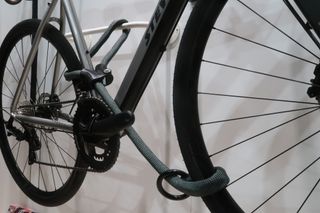In 2023 alone, police in England and Wales received over 64,000 reports of bicycle theft. Whilst that figure marked a 12% decline on the previous year’s tally, bike theft is endemic and the chances of recovery are slim, a situation which is mirrored throughout the world.
Being insured is one thing, but ensuring that your policy covers all eventualities, especially theft, requires a thorough understanding of the fine print.
Every year at least 1 in 20 theft insurance claims are deemed invalid – according to UK Financial Conduct Authority data. For a chunk of bike theft victims that means being hit with the double whammy of having a bike stolen, and not being paid out by their insurer because of a technicality in the small print.
“Be aware, your policy could be easily invalidated by inadvertently breaking some simple rules such as not using an approved bike lock or leaving it unattended for too long in certain locations,” says Lee Evans, bicycle insurance expert at Quotezone.co.uk.
According to Richard Cantle, founder of Stolen Ride policy wordings will vary between different cycle insurance providers. “It can be easy to get caught out for not meeting specific requirements,” explains Cantle, who created the platform in 2012 to help reduce bike theft after experiencing it first-hand. “It’s important to double-check the policy wording of your insurance to make sure you meet all the necessary criteria.”
Reasons your bicycle insurance could become invalid
Policies will vary, but, there are common themes. Where you leave it, why you leave it, and what you lock it with are key factors when it comes to how well your insurance policy covers your bike being nicked.
Your cycle isn’t secured to specification
The latest race content, interviews, features, reviews and expert buying guides, direct to your inbox!

Your bike must be locked to an immovable object – with the lock through the frame and wheels
(Image credit: (Photo by Dinendra Haria/SOPA Images/LightRocket via Getty Images))
Securing your bike is most likely something you do automatically but do check the small print in your policy for any stipulations. “There may be a specific list of approved locks you need to choose from with various ratings, depending on the value of your bike,” says Evans.
“Also, you normally need to have the lock through the main frame and any quick release wheels – secured to an immovable object. If you’re not sure, check with your insurer.”
Take note here too that you should also check your ‘at home bike storage’ – you may need to use an anchor lock cemented into the ground or an immovable object and store the bike out of sight from any windows.
You’re using your bike to make money
If you’re a cycle courier, or you’re using your bike to make an income from – eg; a takeaway delivery rider – then your bike isn’t covered under your standard bicycle insurance. “You will need to take out separate cover such as bicycle courier insurance,” insists Evans.
“It’s because there are more risk factors involved than cycling for pleasure,” adds Evans. “For example, a bicycle courier will likely rack up more time and miles on the road, increasing the likelihood of an accident – the cyclist may also be riding in unfamiliar areas with multiple deliveries to do quickly.”
Bicycle courier insurance also covers a wider range of risks, such as third-party liability – which is required for working as a bicycle courier – and loss or damage to any goods during transit.

Some policies may not cover leaving your bike at a train station
(Image credit: Getty Images)
You left it alone for too long
“Part of the joy of cycling is to explore new places and stop off for breaks and coffees in new towns or villages, it’s not always possible to have the bike locked to an immovable object,” says Michael Kirk, from Quotezone.co.uk. “Some insurance providers say if you leave your bicycle in your eyeline within 5m of where you’re sitting, say grabbing a coffee mid-cycle, then you should still be covered in the event of theft.”
But it’s important to note that all insurance providers are different so cyclists need to check their policies for dos and don’ts. “The small print in your policy may also state how long you can leave your bike unattended for and any separate stipulations on location,” adds Kirk. “For example, some may not cover leaving your bike unattended at a railway station or have a time limit of how long you can do so.”
Your insurance history
If you’ve claimed previously on bicycle insurance, make sure your insurer is aware. If you fail to inform them of any bicycle-related losses in the last three years, they could deny a claim or your insurance could become invalid.

You may not be covered if you’re riding after a few pints, or, taking some medications
(Image credit: Getty Images)
Your record of purchase
If you do make a claim, you will need proof of ownership. The original receipt or a letter from the cycle shop confirming the purchase details with a date included – to help stop people making fraudulent claims. “Most insurance providers stipulate a receipt or purchase details on headed paper from the bicycle shop in question, as valid forms of proof of ownership,” explains Kirk.
“If the cyclist doesn’t have either, it’s best to chat to their insurance provider directly, they may accept a photo with a time and date stamp or a bank statement with details of the purchase transaction. The owner may also need proof that they have purchased an approved lock – to show they’ve taken precautions to stop the bicycle from being stolen.”
Your medications (or, pub rides)
Here’s a random one. Your insurance won’t cover you if you ‘break the law, ride recklessly or if you’re cycling under the influence of drugs or alcohol’. However, some medications specifically say on their small print not to ride a bike if you start to suffer any side effects such as drowsiness or blurred vision. Always check the instructions and if the label says ‘do not operate heavy machinery’ – that often includes riding a bike, so double check with your pharmacist.
Limited chances of recovery
Top targets for thieves
Quietzone.co.uk surveyed 1000 cyclists in June 2024 whilst looking into the possible reasons why insurers may not pay out in the event of your bike being nicked. Their data showed that the types of bikes being targeted by thieves are currently road, mountain and city bikes – with the most popular priced between £1,000 – £2,000, closely followed by the £2,000 to £3,000 bracket. “That makes it important that these bikes are secured correctly and have additional insurance protection,” explains Evans. “You can find savings on bicycle insurance by shopping around, reviewing multi-bike discounts and by paying annually,” adds Evan. “You might also be able to find savings by adding your bicycle to your home insurance so it’s worth double checking – just note, some policies may only cover theft from the home and if the bicycle costs over £1000 it will need to be specified as such on the policy – which may increase the overall premium price.”
“We’re notified of over 500 recoveries of stolen bikes per year,” says James Brown, Managing Director of BikeRegister.com, a database of currently 1.3m bikes, which is used by UK Police forces, to protect and return stolen machines. “We assume that there will be some owners who forget to update the status of their bike to ‘Recovered’ on their account after getting their bikes back, so the number may be more than that.”
But even if double that number are recovered – say, 1000 – out of 64,000 bikes stolen it’s still a measly 1.6% return rate.
Updating the recovered bikes section on BikeRegister needs to be improved by some police forces too, according to Brown. “Some police forces are excellent at doing this, both when bikes are checked in to property stores and on the streets. Other forces may not be as good, due to lack of resources etcetera.”
Registration with BikeRegister is free, but for an upgraded membership you can also buy additional layers of protection such as discreet marking – tagging your bike with hundreds of microscopic UV visible dots – and warning labels.
“We provide the police with the BikeRegister apps to carry out searches on frame numbers and BikeRegister IDs via mobile devices on the street. Insurers such as Bikmo also offer a reduction in premium on BikeRegister marked bikes.”
“But another reason why recovering stolen bikes is such a challenge is the ease of method of disposal,” adds Brown. “With online platforms, like Gumtree and Facebook Marketplace, a bike can be stolen and sold online in a matter of hours.” In the cases where organized thieves essentially steal bike brands to order, the ‘disposal’ time is almost as fast as the theft itself.
Reduce your risk of bike theft

A good locking system is not a guarantee – but – it helps
(Image credit: Future)
A trawl through the X feed of Stolen Ride – a platform set up to help reunite owners with stolen bikes – shows quite how determined thieves can be, “my bike was stolen from a CODED metal bike shed within a GATED community”, one user writes. However, opportunistic thieves can be deterred.
Doing all you can to reduce the likelihood of your bike being stolen will reduce the risk of you having a running battle with your bike insurance firm, too.
- Double lock your bike: Using two high-quality locks, especially a D-lock, makes it harder for thieves to steal your bike. Using different types of locks, like a chain and a D-lock, increases security since thieves are less likely to carry tools for both.
- Go ‘Sold Secure’: Sold Secure approved locks are approved by crime prevention officers and insurance companies. They come in four levels of theft resistance: The Gold and Diamond levels offer the highest protection against thieves using specialized tools such as angle grinders.
- Lock both frame and wheels: Always lock the bike’s frame and both wheels to a solid structure. This makes it harder for a thief to remove parts or take the whole bike.
- Choose secure parking: Always lock your bike in a well-lit, CCTV-monitored, designated cycle parking area. This deters thieves by increasing the chances of getting caught.
- Register your bike: If you’re in the UK, you can “record your bike’s frame number on the National Cycle Database (BikeRegister),” says James Brown. “This helps police trace your bike if it’s stolen and recovered. We also post on our stolen bike gallery – allowing members of the public to contact owners of stolen bikes if they spot it being sold online.”
- Security mark your bike: Marking your bike is an effective visual deterrent. Thieves avoid marked bikes since they are easier to trace and harder to sell. To improve the chances of recovery, cyclists should make it a habit to note down their bike’s serial number and take photos of their bike.
- Prioritize home security: Even at home, lock your bike as securely as you would in public. Avoid advertising that you own a bike by removing visible car racks or creating privacy zones on tracking apps like Strava.
“The most effective method of preventing your bike from being stolen is installing a tracking device like a hidden Apple AirTag or a GPS tracker,” suggests John Vinton, a bike expert specializing in personal security with Aventon Bikes.
“Quality tracking devices can send alerts if the bike leaves a pre-set virtual boundary, or if a third party is tampering with it – you can then provide tracking data and location updates to the police in order to help recover it.”
“But thieves often look for obvious trackers, so you need to get creative with hiding spots,” explains Vinton. “I always recommend tucking it inside the bike frame, especially within the seat post or handlebar stem. These spots keep the tracker well-hidden while still allowing it to transmit a strong signal.”
“E-bike owners have an advantage as the area near the battery compartment offers plenty of room for concealment,” adds Vinton. “The goal is simple: if you have trouble spotting where the tracker is hidden, a thief probably will too.”
“Many insurance companies offer discounts on bicycle insurance premiums when a GPS tracker is installed,” adds Vinton. “This is because GPS trackers increase the chances of recovering a stolen bike, deter potential thieves and provide real-time location data in case of theft.”
It’s an additional expense but worth considering if it means you may be reunited with what’s for some of us is the love of one’s life.

